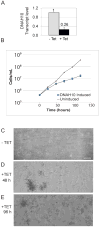Silencing of a putative inner arm dynein heavy chain results in flagellar immotility in Trypanosoma brucei
- PMID: 20888370
- PMCID: PMC2974060
- DOI: 10.1016/j.molbiopara.2010.09.005
Silencing of a putative inner arm dynein heavy chain results in flagellar immotility in Trypanosoma brucei
Abstract
The Trypanosoma brucei flagellum controls motility and is crucial for cell polarity and division. Unique features of trypanosome motility suggest that flagellar beat regulation in this organism is unusual and worthy of study. The flagellar axoneme, required for motility, has a structure that is highly conserved among eukaryotes. Of the several dyneins in the axonemal inner arm complex, dynein f is thought to control flagellar waveform shape. A T. brucei gene predicted to encode the dynein f alpha heavy chain, TbDNAH10, was silenced using RNA interference in procyclic T. brucei cells. This resulted in immotile flagella, showing no movement except for occasional slight twitches at the tips. Cell growth slowed dramatically and cells were found in large clusters. Microscopic analysis of silenced cultures showed many cells with detached flagella, sometimes entangled between multiple cells. DAPI staining showed an increased frequency of mis-positioned kinetoplasts and multinucleate cells, suggesting that these cells experience disruption at an early cell cycle stage, probably secondary to the motility defect. TEM images showed apparently normal axonemes and no discernable defects in inner arm structure. This study demonstrates the use of RNAi as an effective method to study very large genes such as dynein heavy chains (HCs), and the immotility phenotype of these dynein knockdowns suggests that an intact inner arm is necessary for flagellar beating in T. brucei. Since analogous mutants in Chlamydomonas reinhardtii retain motility, this phenotype likely reflects differences in requirements for motility and/or dynein assembly between the two organisms and these comparative studies will help elucidate the mechanisms of flagellar beat regulation.
Copyright © 2010 Elsevier B.V. All rights reserved.
Figures





Similar articles
-
Knockdown of Inner Arm Protein IC138 in Trypanosoma brucei Causes Defective Motility and Flagellar Detachment.PLoS One. 2015 Nov 10;10(11):e0139579. doi: 10.1371/journal.pone.0139579. eCollection 2015. PLoS One. 2015. PMID: 26555902 Free PMC article.
-
Stuck in reverse: loss of LC1 in Trypanosoma brucei disrupts outer dynein arms and leads to reverse flagellar beat and backward movement.J Cell Sci. 2007 May 1;120(Pt 9):1513-20. doi: 10.1242/jcs.004846. Epub 2007 Apr 3. J Cell Sci. 2007. PMID: 17405810
-
Structural analysis of flagellar axonemes from inner arm dynein knockdown strains of Trypanosoma brucei.Biocell. 2012 Dec;36(3):133-41. Biocell. 2012. PMID: 23682429
-
The flagellum of Trypanosoma brucei: new tricks from an old dog.Int J Parasitol. 2008 Jul;38(8-9):869-84. doi: 10.1016/j.ijpara.2008.03.003. Epub 2008 Mar 28. Int J Parasitol. 2008. PMID: 18472102 Free PMC article. Review.
-
Parasites in motion: flagellum-driven cell motility in African trypanosomes.Curr Opin Microbiol. 2010 Aug;13(4):459-65. doi: 10.1016/j.mib.2010.05.015. Epub 2010 Jun 28. Curr Opin Microbiol. 2010. PMID: 20591724 Free PMC article. Review.
Cited by
-
Trypanosoma cruzi gene expression in response to gamma radiation.PLoS One. 2012;7(1):e29596. doi: 10.1371/journal.pone.0029596. Epub 2012 Jan 11. PLoS One. 2012. PMID: 22247781 Free PMC article.
-
Knockdown of Inner Arm Protein IC138 in Trypanosoma brucei Causes Defective Motility and Flagellar Detachment.PLoS One. 2015 Nov 10;10(11):e0139579. doi: 10.1371/journal.pone.0139579. eCollection 2015. PLoS One. 2015. PMID: 26555902 Free PMC article.
-
Centrin3 in trypanosomes maintains the stability of a flagellar inner-arm dynein for cell motility.Nat Commun. 2014 Jun 3;5:4060. doi: 10.1038/ncomms5060. Nat Commun. 2014. PMID: 24892844 Free PMC article.
-
Genome-scale RNA interference profiling of Trypanosoma brucei cell cycle progression defects.Nat Commun. 2022 Sep 10;13(1):5326. doi: 10.1038/s41467-022-33109-y. Nat Commun. 2022. PMID: 36088375 Free PMC article.
-
Trypanosome doublet microtubule structures reveal flagellum assembly and motility mechanisms.Science. 2025 Mar 14;387(6739):eadr3314. doi: 10.1126/science.adr3314. Epub 2025 Mar 14. Science. 2025. PMID: 40080582
References
-
- Asai DJ, Wilkes DE. The dynein heavy chain family. J Eukaryot Microbiol. 2004;51:23–29. - PubMed
-
- Baron DM, Kabututu ZP, Hill KL. Stuck in reverse: loss of LC1 in Trypanosoma brucei disrupts outer dynein arms and leads to reverse flagellar beat and backward movement. J Cell Sci. 2007;120:1513–1520. - PubMed
-
- Bastin P, Sherwin T, Gull K. Paraflagellar rod is vital for trypanosome motility. Nature. 1998;391:548. - PubMed
-
- Branche C, Kohl L, Toutirais G, Buisson J, Cosson J, Bastin P. Conserved and specific functions of axoneme components in trypanosome motility. J Cell Sci. 2006;119:3443–3455. - PubMed
-
- Broadhead R, Dawe HR, Farr H, et al. Flagellar motility is required for the viability of the bloodstream trypanosome. Nature. 2006;440:224–227. - PubMed
Publication types
MeSH terms
Substances
Grants and funding
LinkOut - more resources
Full Text Sources

